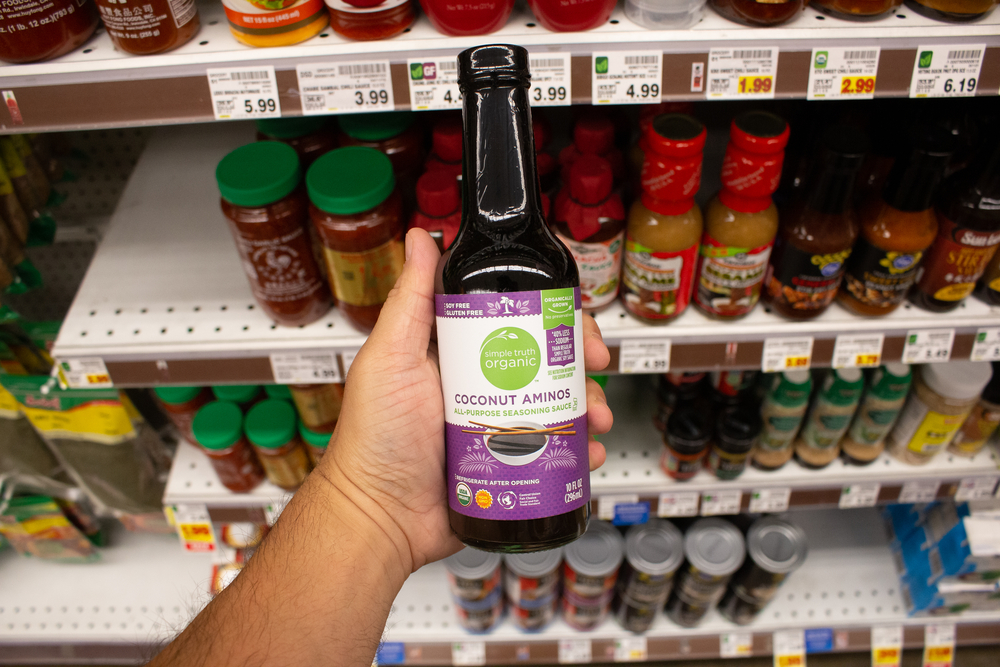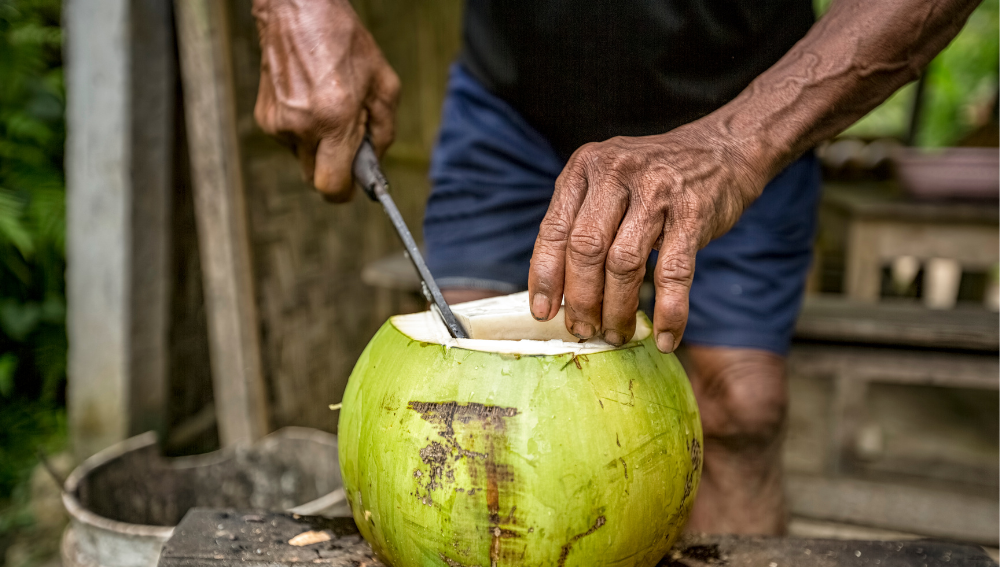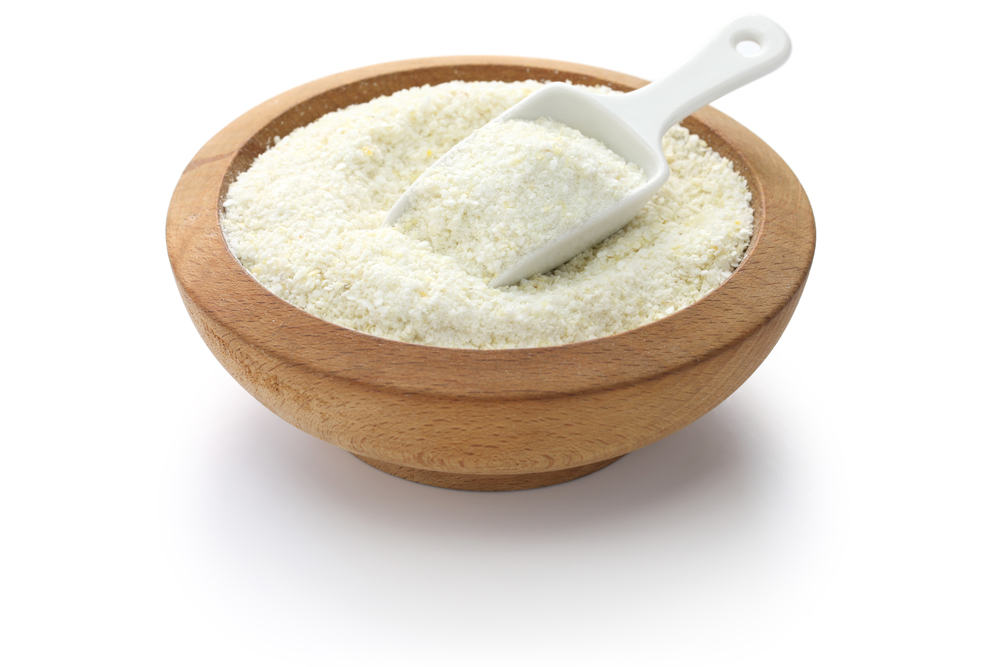In recent years, the popularity of alternative condiments has increased as people look for healthier options to replace traditional soy sauce.
Two such alternatives, tamari and coconut aminos, have become favorites for those seeking to enhance flavors in their meals without resorting to artificial additives or excessive amounts of sodium.
This article will explore tamari and coconut aminos, delving into their respective origins, production processes, and nutritional benefits.
Tamari is derived from the Japanese soy sauce family and is known for its rich, savory flavor. As a gluten-free option, it allows those with gluten intolerance or sensitivity to enjoy their favorite dishes without compromising their dietary restrictions.
On the other hand, coconut aminos come from the sap of coconut blossoms, offering a sweeter, subtler taste, and is free of soy, making it friendly for those with soy allergies or following a paleo diet.
As both tamari and coconut aminos gain traction in the culinary world, understanding their unique qualities and applications in various dishes is crucial in determining the best option for individual preferences and dietary needs.
Let’s learn more about these versatile condiments and how they can be incorporated into daily cooking routines.
Key Takeaways
- Tamari is a gluten-free soy sauce alternative with a rich, savory flavor.
- Coconut aminos are derived from coconut blossoms and offer a sweeter taste, being soy-free and paleo-friendly.
- Understanding the differences and uses of tamari and coconut aminos is essential for choosing the right alternative for individual preferences and dietary requirements.
Understanding Tamari
Origin and Production
Tamari originated in Japan as a byproduct of miso paste production. It is made from fermented soybeans, giving it a rich, umami flavor. The production process is similar to that of traditional soy sauce, but with some key differences.
Tamari contains little to no wheat, making it a popular gluten-free alternative to soy sauce. The fermentation process is also typically longer, resulting in a thicker, more concentrated sauce.
Nutrition and Health Benefits
Tamari offers a range of health benefits due to its unique composition. Since it is gluten-free, it is an ideal choice for individuals with gluten sensitivities or celiac disease.
Additionally, tamari is often lower in sodium compared to traditional soy sauce, which can be beneficial for those watching their salt intake.
Some key nutritional aspects of tamari include:
- Gluten-free: Suitable for individuals with gluten sensitivities
- Lower in sodium: Helps those looking to reduce salt consumption
- Umami flavor: Adds depth and richness to dishes
Taste and Uses
Tamari has a deep, savory umami flavor that is more pronounced and slightly less salty than conventional soy sauce. It is commonly used in Japanese cuisine and can be found in various dishes, including sushi, sashimi, and marinades.
Its darker and thicker texture makes it ideal for dipping and as a finishing sauce. Tamari can also be used as a replacement for dark soy sauce in Chinese and other Asian recipes.
Some common uses for tamari include:
- Dipping sauce for sushi and sashimi
- Marinades for meats and vegetables
- Added flavor to soups and stews
- Enhancing the taste of stir-fry dishes
Notable Brands
San-J and Eden Organic are two well-known brands that produce high-quality tamari. These brands are praised for their authentic methods and commitment to using only the finest ingredients.
By choosing a reputable tamari brand, you can enjoy the depth of flavor and quality that this Japanese condiment has to offer.
Getting to Know Coconut Aminos
Origin and Production
Coconut aminos is a gluten-free, soy-free alternative to soy sauce, made from the sap of coconut trees. The production process involves tapping the coconut tree sap, followed by fermenting and evaporating it to create a condiment with a umami flavor.
Coconut aminos has gained popularity among those following paleo, Whole30, and keto diets as a healthier, low-sodium option in comparison to soy sauce.
Nutrition and Health Benefits
Coconut aminos offers several health benefits, including:
- Gluten-free and soy-free: This makes it suitable for those with gluten or soy sensitivities or allergies.
- Lower in sodium: Coconut aminos contains about 90mg of sodium per teaspoon, which is significantly lower than traditional soy sauce containing around 290mg per teaspoon. This makes it a more heart-friendly option for those watching their sodium intake.
- Nutrient-dense: Coconut tree sap is rich in minerals, vitamins, and amino acids, which contribute to a healthy diet.
Taste and Uses
Coconut aminos has a distinct umami flavor, with a slightly sweeter and milder taste than soy sauce. It can be used as an ingredient or condiment in various recipes like stir-fries, marinades, dressings, and sauces.
Its versatility makes it an ideal choice for those following specific diets, such as paleo, keto, or Whole30, or simply seeking a healthier alternative to soy sauce.
Notable Brands
Coconut Secret is one of the leading brands producing coconut aminos. They pride themselves on sourcing their coconut sap from sustainable organic farms and following a natural fermentation process.
Other popular brands include Trader Joe’s and Big Tree Farms, which also offer high-quality coconut aminos products.
Commonalities and Differences
Flavor Profiles
Both tamari and coconut aminos are popular alternatives to traditional soy sauce and can be used as seasonings to enhance the taste of various dishes. Tamari, a byproduct of miso production, is known for its rich, savory flavor with a noticeable umami taste.
It has a thicker consistency and less salty taste compared to regular soy sauce. On the other hand, coconut aminos is a seasoning derived from the sap of coconut trees. It has a subtly sweet, slightly tangy flavor, and milder taste than tamari.
Health Considerations
When it comes to health, there are distinct differences between tamari and coconut aminos. Tamari is a gluten-free option, making it suitable for people with gluten allergies or sensitivities.
It is made by fermenting soybeans, which gives it a high protein content. However, it can still contain high sodium levels, although lower than traditional soy sauce.
Coconut aminos is not only gluten-free but also soy-free, making it an excellent option for those with allergies or dietary restrictions.
It has a significantly lower sodium content compared to tamari, making it a healthier alternative for people who are looking to reduce their sodium intake. Moreover, coconut aminos contains several essential amino acids and beneficial minerals.
| Tamari | Coconut Aminos | |
|---|---|---|
| Gluten | Gluten-free | Gluten-free |
| Soy | Contains soy | Soy-free |
| Sodium | High | Lower |
| Nutrients | High protein | Amino acids, minerals |
Culinary Applications
In terms of cooking, both tamari and coconut aminos can be used in a variety of recipes and applications, often as a substitute for soy sauce. They can be used in a 1:1 ratio when replacing soy sauce in most recipes.
Tamari works well as a marinade, seasoning, and dipping sauce, especially in dishes that require a robust flavor profile. It enhances the umami taste in recipes, making it ideal for stir-fries, grilling, and sautéing.
Coconut aminos, with its subtler and slightly sweeter taste, can also be used as a marinade, seasoning, and dipping sauce. It pairs well with flavors like ginger and garlic and can be used in various cuisines, from Asian-inspired to tropical dishes.
In summary, both tamari and coconut aminos offer unique flavor profiles and health benefits, making them suitable alternatives to traditional soy sauce. Their versatility in culinary applications ensures that they can be easily incorporated into a variety of recipes and dishes.
How to Substitute Tamari and Coconut Aminos
When looking for ways to substitute tamari and coconut aminos, it’s essential to keep both local dishes and personal preferences in mind. Here, we’ll go through a few effective substitutes that can be used when cooking at home or dining out.
Cooking At Home
Tamari is a popular seasoning in various dishes like soups, marinades, and salad dressings. It’s commonly used in recipes like fried rice, stir-fries, miso, and gyoza.
Being a gluten-free alternative to regular soy sauce, it’s an excellent option for those with allergies. However, some may still want a substitute. In such cases, consider the following options:
- Soy Sauce: Gives a similar umami flavor, but be aware of the gluten content.
- Miso: A fermented soybean paste that can be thinned with water for a similar consistency.
- Reduced-sodium soy sauce: For a lower sodium option, this is an option worth considering.
Coconut Aminos is a soy-free and gluten-free alternative made from coconut palm sap. It can be used in dishes like dipping sauces and salad dressings and is considered allergy-friendly. If you need a substitute for coconut aminos, the following alternatives could be used:
- Tamari: Offers a similar taste and has no gluten, but contains soy.
- Soy Sauce: A go-to alternative; however, keep in mind its gluten and soy content.
- Reduced-sodium soy sauce: For those watching their sodium intake, this can be a handy option.
Dining Out
When dining out, it’s crucial to communicate your preferences with the restaurant staff, especially if you have dietary restrictions or allergies.
Here’s how to navigate substitutions for tamari and coconut aminos when eating at a restaurant:
- Request a substitution: Inform the waiter about your dietary needs or allergies and ask for an appropriate alternative (e.g., substituting coconut aminos for tamari, or vice versa).
- Choose a dish with similar flavor profiles: If a direct substitution is not available, opt for dishes that already use the alternative ingredient.
- Bring your own: If you have specific alternatives you prefer, consider carrying a small bottle of your preferred option to enhance your dining experience and make it allergy-friendly, as needed.
Tamari and Coconut Aminos in International Cuisine
Asian Recipes
Tamari and coconut aminos are popular sauce choices in Asian recipes, often used as soy sauce alternatives. Their rich, savory flavors enhance many Asian dishes such as stir-fries, soups, and sushi.
In stir-fries, both tamari and coconut aminos serve as excellent replacements for soy sauce. They can be added to the dish along with other ingredients like vegetables, meats, and fish for a flavorful outcome:
Stir-Fry Example:
- 2 tablespoons tamari or coconut aminos
- 1 tablespoon vegetable oil
- 1 pound mixed vegetables (cooked or raw)
- 1 pound cooked protein (chicken, beef, or tofu)
- Optional: garlic, ginger, and onion for more flavor
Due to their versatility, both sauces can also be used in miso dishes, such as miso soup. They are often combined with ingredients like tofu, green onions, and seaweed.
Miso Soup Example:
- 4 cups water
- 2 tablespoons miso paste
- 1 tablespoon tamari or coconut aminos
- 1 cup diced tofu
- 1/4 cup sliced green onions
- Optional: seaweed and mushrooms
Similarly, sushi dishes can benefit from the flavors of tamari and coconut aminos. They can be served as dipping sauces alongside sushi rolls or sashimi.
Western Recipes
Tamari and coconut aminos are not restricted to only Asian dishes; they find their way into various Western recipes too. For instance, they can be used as delicious salad dressings, adding depth and umami to salads.
Salad Dressing Example:
- 1/4 cup tamari or coconut aminos
- 1/4 cup olive oil
- 2 tablespoons lemon juice
- 1 tablespoon honey
- Optional: garlic and crushed red pepper flakes for extra flavor
Fried rice dishes can be elevated with the addition of tamari or coconut aminos, whether it’s traditional fried rice or healthier alternatives like cauliflower fried rice.
Cauliflower Fried Rice Example:
- 1 small head of cauliflower, processed into rice-sized pieces
- 1 tablespoon vegetable oil
- 1/4 cup diced onion
- 1 cup mixed vegetables (cooked or raw)
- 1/2 cup cooked protein (chicken, shrimp, or tofu)
- 2 tablespoons tamari or coconut aminos
- Optional: garlic, ginger, and an egg for more flavor
Ultimately, the diversity of tamari and coconut aminos allows them to be used in an array of recipes, both Asian and Western, providing delicious, soy-free alternatives for sauces, salad dressings, and more.
Frequently Asked Questions
What are the main differences between tamari and coconut aminos?
Tamari is a Japanese sauce made from fermented soybeans, while coconut aminos is derived from the sap of coconut trees. Tamari is generally thicker and richer in flavor compared to coconut aminos, which has a lighter, sweeter taste.
How do the health benefits of tamari and coconut aminos compare?
Both tamari and coconut aminos offer health benefits due to their fermentation process, which promotes good gut health. Tamari is rich in protein and contains essential amino acids.
Coconut aminos, on the other hand, contain minerals, antioxidants, and low glycemic properties. While both provide nutritional benefits, individuals with specific dietary requirements may prefer one over the other.
Are both tamari and coconut aminos gluten-free?
Tamari is commonly gluten-free, as it is made from soybeans without the addition of wheat. However, it’s important to check labels for certification, as some tamari products may contain small amounts of gluten. Coconut aminos, being derived from coconut sap, is inherently gluten-free.
Can coconut aminos be used as a substitute for tamari?
Yes, coconut aminos can be used as a substitute for tamari, particularly for those looking for a soy-free and gluten-free alternative.
However, the flavor profile differs, with coconut aminos being sweeter and less salty than tamari. When substituting, adjustments in seasoning may be required to achieve the desired taste.
How does the taste of tamari differ from coconut aminos?
Tamari has a deep, rich, and savory taste with a distinct umami flavor, while coconut aminos presents a lighter, sweeter, and slightly tangy profile.
Tamari is also saltier compared to coconut aminos, so it’s essential to consider these differences when substituting one for the other in recipes.
What are the nutritional differences between tamari and coconut aminos?
Tamari is higher in sodium and has a slightly higher protein content compared to coconut aminos.
Coconut aminos, being lower in sodium and with a lower glycemic index, may be a preferred option for individuals watching their sodium intake or managing their blood sugar levels. Additionally, coconut aminos contain various minerals and antioxidants, while tamari offers essential amino acids.







